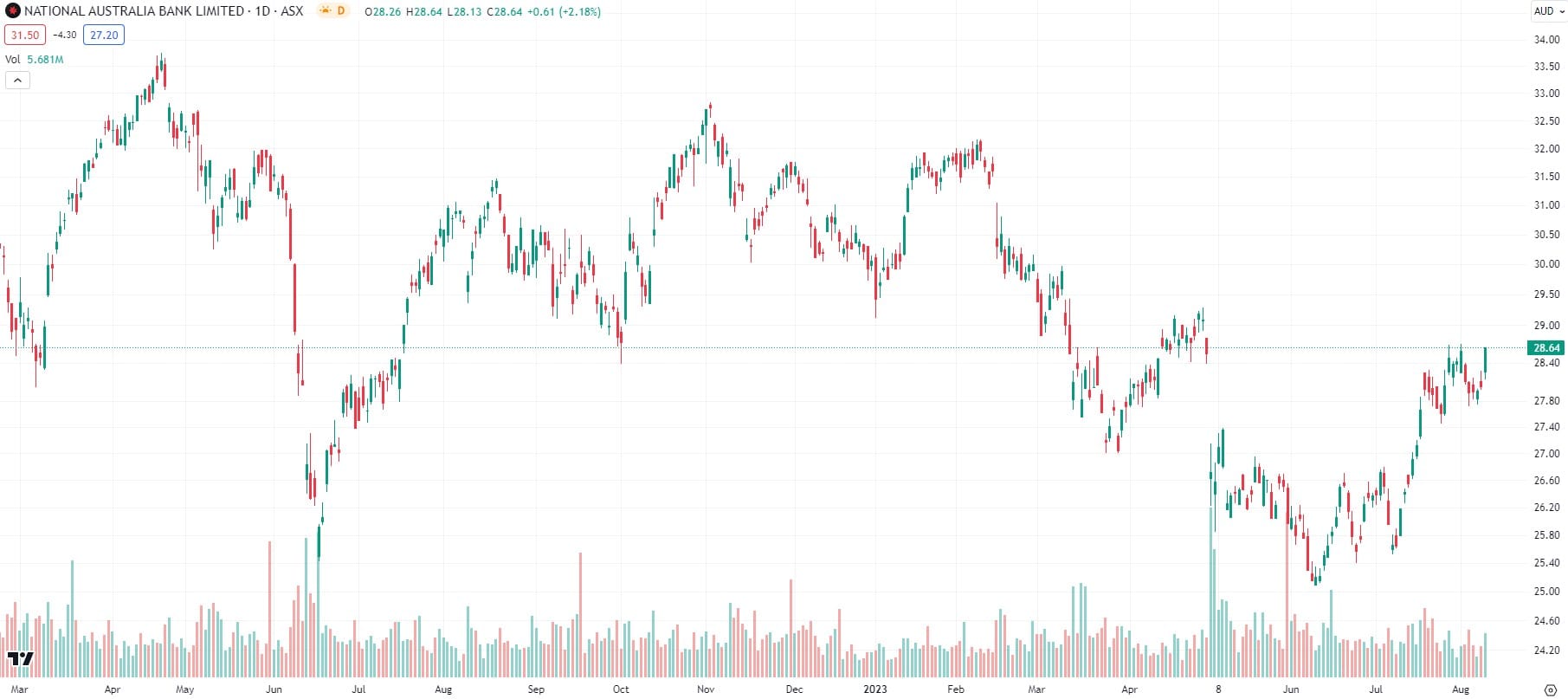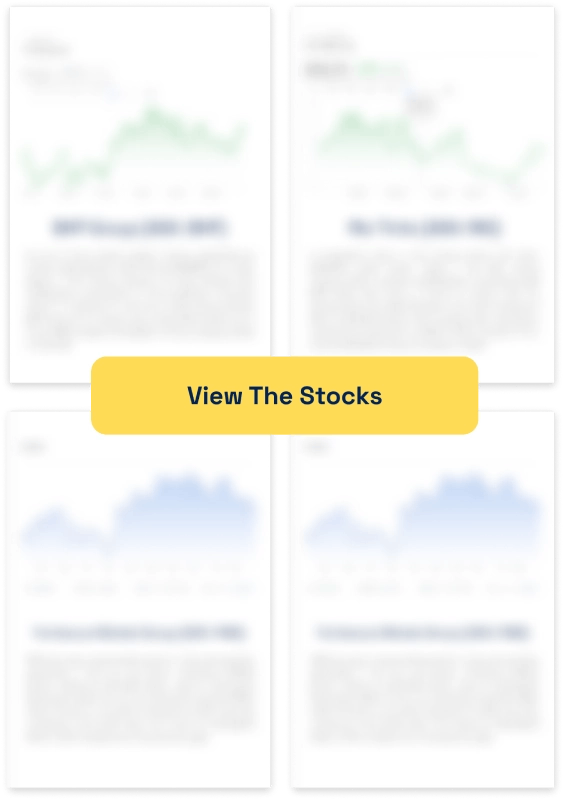Is NAB (ASX: NAB) the best Big 4 bank?
![]() Nick Sundich, August 10, 2022
Nick Sundich, August 10, 2022
NAB (ASX: NAB) is one of Australia’s so-called “Big Four” Banks and is the second largest by market capitalization – only trailing CBA (ASX: CBA). This company provides banking services, particularly deposit accounts and loans to customers in Australia and overseas.
Compared to its peers it has a larger exposure to the business lending market and has positive trading momentum, turning itself around following the Banking and Financial Services Royal Commission and the hiring current CEO Ross McEwan.
But since peaking in April 2022, shares are down 13%, even in spite of 12 straight interest rate increases. Shouldn’t shares have gone in the other direction?
First published April 2022, last updated August 2023
What are the Best ASX stocks to invest in right now?
Check our buy/sell tips on the top ASX stocks:
The COVID lending boom rolled on for NAB
NAB made back to back $6bn+ profits in FY21 and FY22 (NAB uses October 1-September 30 as its financial year), making a 10.3% and 11.7% ROE respectively. After paying $1.68 per share in FY19 and dropping to $0.60 per share in FY20 as the pandemic hit, it paid 67c per share in FY21 and 78c per share in FY22.
The bank’s earnings were lifted by higher business and housing lending volumes, increased fees and commissions as well as increased risk management income in its Markets and Treasury division. NAB’s mortgage book rose by $8bn and its credit card operations doubled after buying Citi’s retail banking arm.
However, it was a case of high-volume but low-margin business. The bank’s Net Interest Margin (NIM) fell to 1.64%, following roughly two years of record low interest rates.
…until it didn’t
Fast forward to August 2023 and the bank is three quarters of the way through FY23.
In the first half, it made a $4bn profit and a 13.7% ROE, but its NIM was just 1.77% as at the end of 1HY23. Why?
Because of the ‘mortgage wars’. Customers who are rolling off their fixed interest rates are seeking better deals. Banks have had to offer slightly lower interest rates and other sweeteners too that eat into profitability – particularly cashback offers.
And if customers use a broker (which is roughly half of them), banks have to pay commissions and that hits margins further. NAB, like Westpac and CBA, have given up cashback offers.
Other things that haven’t helped NAB’s cause have been the US regional banking crisis as well as Westpac and ANZ putting past issues impacting their share prices behind them.
In respect of Westpac, it was the regulatory issues. For ANZ, it was how it was suffering commercially through inferior technology that took it so long to approve home loans.
Since peaking in April 2022, shares are down 13%.

NAB (ASX:NAB) share price chart, log scale (Source: TradingView)
What next?
Investors may remember that the early 1990s recession caused loan losses that nearly caused Westpac to go out of business.
NAB has the highest owner-occupier arrears of all the major banks at 1.4%. Although this is lower than many non-bank lenders, some of which are above 5%, this figure could well increase as interest rate hikes continue to bite.
If owners sell the property at a loss, the banks may get all the money they lent back but will no longer be getting interest.
NAB has cut cashback offers, but while this helps margins on existing loans, it is clearly a step back from getting new business through the door.
Consensus estimates for the full FY23 suggest $2.39 EPS, up 12% from the year before. However, a 7% decline is forecast for FY24 and whilst a 3% increase is forecast for FY25, this is below FY23.
The mean target share price is $27.73, a 3% discount to the $28.64 share price.
Its P/E is just 12.9x, behind CBA’s 18.7x but ahead of ANZ and Westpac’s 11x and 10.9x multiple respectively.
It is trading at 1.43x Price to Book, again behind CBA (at over 2x) but ahead of Westpac and ANZ (1.1x for both).
So is NAB the best ASX bank stock?
Overall, although we said so when we first published this article in April 2022, we don’t think it is anymore.
We think if an investor was going to buy a Big 4 bank share, CBA would be the best bet for reasons outlined in this article.
NAB did well to turn itself around post the Royal Commission, but part of the reason it increased was because of the struggles of its peers that have since been overcome.
However, we would not recommend investing in the banks right now. The sector is lagging the rest of the ASX given the intense competition and we think fittingly so. There are better opportunities out there at the moment.
Stocks Down Under Concierge is here to help you pick winning stocks!
The team at Stocks Down Under have been in the markets since the mid-90s and we have gone through many ups and downs. We have written about every sector!
Our Concierge BUY and SELL service picks the best stocks on ASX. We won’t just tell you what to buy – we give you a buy range, price target and stop loss level in order to maximise total returns. And we will only recommend very high conviction stocks where substantial due diligence has been conducted.
Our performance is well ahead of the ASX200 and All Ords.
You can try out Concierge for 14 days … for FREE.
Get a 14-day FREE TRIAL to CONCIERGE now
There’s no credit card needed – the trial expires automatically.

Frequently Asked Questions about NAB
- What is NAB?
NAB (ASX: NAB) is one of Australia’s Big Four Banks.
- Does NAB pay a dividend?
Yes, NAB pays a dividend. It paid $1.27 in FY21, fully franked and representing a yield of 3.8%.
- Is NAB Australian owned?
It has Australian shareholders, but some foreign shareholders too. Ultimately, it is difficult to deduce because a significant portion of shareholders own shares through custodianship agreements and their identities are hidden to the general public.
- Is NAB an ethical company?
NAB has placed an increasing focus on ESG in recent years, but whether investors think NAB is an ethical company will depend on how the company is performing on metrics most important to individual investors. On the climate change front, it is targeting a Net Zero lending portfolio by 2050, is looking to source 100% of its own energy from renewable sources by 2025 and has joined the UN-convened Net Zero Banking Alliance. It has also lent more than any other Australian bank to renewable energy projects since 2003.
Blog Categories
Get Our Top 5 ASX Stocks for FY25
Recent Posts
Your invitation to the Freelancer Investor Day
Your invitation to the Freelancer Investor Day Freelancer (ASX: FLN) is a Sydney-based company that has been the subject of…
Kamala Harris stocks: If Joe Biden’s VP wins the White House in 2024, which stocks will win?
With the US Presidential election now certain to be a Kamala Harris v Donald Trump showdown, we’ve looked at so-called…
South32 (ASX:S32): Is it the dark horse amongst ASX 200 miners or have cyclones and commodity prices hit it too hard?
South32 (ASX:S32) began life as a spinoff from BHP back in 2015, capitalised at $9bn. In mid-2024, it is capped…




